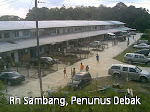



TheSundayPost/April 28, 2009
Preservatives are found in most processed and semi-processed food. But how many consumers take the trouble to find out the functions of these ingredients and whether they are really safe?
MONOSODIUM glutamate (MSG), benzoic acid, citric acid, synthetic and plant-based food additives, stabilisers and flavour enhancers.
These are some of the common (and less common) preservatives found in processed and semi-processed food we eat daily.
But as consumers, do we know or care about what the functions of these ingredients actually are and whether they are safe?
About three months ago, a local food manufacturer and supplier shocked many people by adding a large amount of the preservative, benzoic acid, into his food item.
Officers from the Divisional Health office in Kuching City detected this while carrying out food sampling at a mini department store. They took a piece of the food item sold there and sent it to the Chemistry Department for analysis.
The result showed the food item contained a high content of benzoic acid, an additive prohibited under Regulation 20 and Regulation 63 of Food Regulations 1985 read together with Section 13B(2)(d) of Food Act 1983.
The manufacturer was slapped with a hefty fine.
According to Public Health Law health inspector and prosecuting officer Samuil-Ashton Satu, who took charge of the case, three types of chemicals permitted and commonly used are sulphur dioxide, benzoic acid and sorbic acid.
But he pointed out that this did not mean the preservatives could be used for all types of food. “Take benzoic acid for instance. You can’t use it on cider because it causes negative chemical reactions.”
He said preservatives were used to inhibit or stop the fermentation process.
“Basically, it is for arresting the process of decomposition, fermentation and acidification in certain food. Herbs, spices or vinegar are not included.”
Samuil said some people tended to go overboard when using preservatives just to make their product last longer and look fresher without caring about the consequences.
He said there had been incidents where boric acid was used even though the chemical is banned worldwide.
“It is so powerful that if you go to a factory using boric acid, you won’t find any flies, cockroaches and ants around. Normally, if traders use the chemical in their products, it would probably be for yellow noodles or mee kuning.”
Samuil said the most common misuse of benzoic acid was found among traders who mixed it with certain food when they were not supposed to or used it over the permissible level.
He has come across high level of benzoic acid in many food items including soy sauce, fish cake, fish ball, preserved fruits, yellow noodles, salted raddish, kuey tiaw, tomato sauce, barbecue sauce and cheese bits.
In 2007 alone, he witnessed cases of high benzoic acid level in noodle, preserved fruits and a certain chilli sauce, and also came across instances of boric acid found in some yellow noodles and ‘kolok’ mee.
In 2008, he revealed that the State Health Department took up 16 cases on preservatives misuse, of which six involved sorbic acid found in curry mix, prawn paste, cuttle fish and cincalok. Here, the chemical was used above the permissible level.
He said seven cases were brought to court, including one held over from 2007.
Samuil said the heaviest penalty for misusing preservatives is RM100,000 or not exceeding 10 years in prison or both. For this, however, the authorities would have to prove the food is injurious to human beings.
He said offenders could also be charged for serving or selling food unfit for human consumption. This entails a fine not exceeding RM50,000 or imprisonment of eight years or both.
For adulterated food, he said the fine was RM20,000 or imprisonment not exceeding five years or both.
“So far in Sarawak, no one has been fined RM100,000 but there is one case (pesticides in vegetables) I took up in the Sessions Court where the judge said he could impose a heavy fine but the offender could still pay up. So instead, the judge gave him three months’ jail.”
For repeat offenders, the court will increase the penalty and can even order the business to shut down. Regular follow-up checks will also be carried out on past offenders.
According to Samuil, the State Health Department has a food safety and quality unit to collect samples for analysis from food premises and shops.
He said these checks were ongoing and done either through routine inspection or after public complaints.
“In Sarawak, the most dangerous substance we have ever come across is a non-nutritive substance such as saccharine and cyclamate which are banned.
Saccharine can only be used under a doctor’s supervision while cyclamate tends to be used in preserved fruits,” he added.
The department has found cyclamate in pudding jelly sticks, pudding cups, white papaya strips, sunflower seeds, ginseng lime and preserved fruits and if taken over a prolonged period, it can cause testicular atrophy (shrinking testes) and to a extent, infertility.
Another thing to watch out for is colouring substance and the ones normally detected by the department are tartrazine and sunset yellow FCF in tea, normally served in coffeeshops. The law does not permit colouring to be added to tea.The other type of colouring used is Orange 2 which is banned but often used in preserved fruits.
Samuil conceded it was difficult to stop people selling such food items because Malaysia had an open market - so the best prevention is regular inspection and sampling.
He said presently, the department rarely received public complaints, most probably because people were not aware of their rights to complain.
“Consumers might not know certain foods are adulterated with all sorts of chemicals but they should not hesitate to lodge a complaint if they found something suspicious.”
He stressed it was the consumer’s right to demand labelling and an explanation if the food served did not come up to the expected standard.
“Consumers have to be proactive and wise about what they eat,” Samuil said food manufacturers and suppliers must know which preservatives were permitted or banned.
“They should also know the requirements under the Food Act and Regulations. If they don’t, it’s high time they find out.”
Meanwhile, Sarawak Manufacturers Association (SMA) president Datuk Hii Ngo Sing advised manufacturers, particularly of food and drinks, to stick strictly to the permissible levels of chemicals used and avoid preservatives, artificial colouring and ingredients that could harm the health of consumers.
“Be responsible manufacturers, and if you aren’t sure about what is allowed or otherwise, check with the Health Department and Domestic Trade and Consumers’ Affairs Ministry,” he advised.
He called on the authorities to carry out regular surveillance on manufacturers to ensure they did not taint their food and drinks with harmful substances.
“None of our members is a kuey tiaw member but we have a few who manufacture biscuits, chilly or tomato sauce and instant noodles. The rest is into building materials for construction,” he said.
Consumers Association of Penang (CAP) president SM Mohamed Idris urged the Health Ministry to conduct an immediate nationwide check and crackdown on the illegal use of benzoic acid in noodles and other food products.
“The ministry should institute more control over the sale of benzoic acid,” he said. Mohamed pointed out that the maximum fine and a jail term should be imposed on offenders and information on the action taken by the ministry widely disseminated to heighten public awareness and deter would-be offenders.
“Swift and firm action will demonstrate to errant traders that the government is serious in tackling the problem and will not tolerate abuse.”
Mohamed said in Penang last year, the association discovered a high level of benzoic acid in several samples of noodles or ‘hor fun’. CAP tested the noodles given by concerned members of the public and found they contained 2,291 parts per million (ppm) of benzoic acid.
According to the Food Act 1983 & Regulations, benzoic acid is permitted in only a very limited list of processed foods such as chilli paste, fermented soya products, belacan (shrimp paste), drink concentrates, some pickled or dried fruits and vegetables and sauces.
“Except for drink concentrates which require dilution, the maximum level permitted by law in these foods does not even exceed 1,000 ppm in any instance,” Mohamed explained.
“Benzoic acid is strictly prohibited in noodles. In fact, the Food Act makes no provision for preservatives to be added to any type of pasta which includes noodles, bee hoon (vermicelli), laksa, macaroni and spaghetti.”
“But not only is benzoic acid present where it should not even be, the levels detected in a great number of the samples are also extremely high — much more than even the highest permitted level under the Food Act,” he said.
According to a World Health Organisation (WHO) report, benzoic acid has been associated with asthma, rhinitis, urticaria and anaphylactic shock in sensitive individuals.
In one study where volunteers were administered with doses of benzoic acid over a few days, marked symptoms of discomfort and nausea, headache, weakness and burning of the oesophagus were reported.
Benzoic acid has also been linked to hyperactivity in children. This chemical is easily available in shops without any restrictions on its sale to the public.
According to online dictionary, Wikipedia, benzoic acid is a colourless crystalline solid and the simplest aromatic carboxylic acid. This weak acid and its salts are used as a food preservative and it is an important precursor for the synthesis of many other organic substances.
Benzoic acid inhibits the growth of mold, yeast and some bacteria. It is either added directly or created from reactions with its sodium, potassium or calcium salt.
Acidic food and beverage like fruit juices (citric acid), sparkling drinks (carbon dioxide), soft drinks (phosphoric acid), pickles (vinegar) or other acidified food are preserved with benzoic acid and benzoates.
Typical levels of use for benzoic acid as a preservative in food are between 0.05 - 0.1 per cent. Foods in which benzoic acid may be used and maximum levels for its application are laid down in international food law.










No comments:
Post a Comment